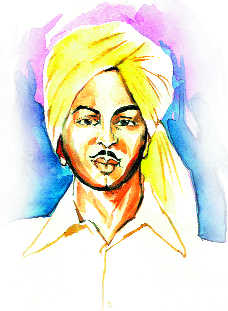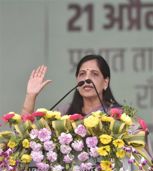
Bhagat Singh
M Rajivlochan
As the world braces for young men and women who are eager to use violence in order to liberate humankind in the name of Islam, we would do well to read this account of revolutionary politics in India.
Here too the protagonists were driven by ideology and were willing to heap destruction and devastation on those who stood in the way of their achieving success. ‘Further on everybody is hereby requested to abstain from offering any sort of assistance to our enemies…. Anybody acting contrary will be severely dealt,’ said the notice that Bhagat Singh and his comrades issued to the public in 1928.
In a well-researched book, Maclean makes an effort to put before us the complex interactions between Indian revolutionaries, Gandhian politics and the colonial government.
Each was driven by an ideology, except that the ideas that underpinned revolutionary action seemed to gain strength from the belief that violence and murder were the most appropriate ways of reclaiming one’s honour even if the persons who got murdered were innocent of any wrong doing.
The most romantic years for revolutionary politics were those between the two World Wars. The brush with revolution that the members of the Ghadar party had during the war years had been effectively silenced by police action.
The Ghadar had not been able to move the people at all to rise against the government. After the war, however, revolutionary politics seemed to capture the imagination of the people of India with thousands following the travails of Bhagat Singh and his colleagues. So much so, that it was rumoured — contrary to all available information — that Mahatma Gandhi refused to save Bhagat Singh from the gallows because he felt politically threatened by the support that Bhagat Singh was able to garner from the public.
In this book, Gandhi continues to provide the essential foil for understanding the rhetoric of revolution. Thus the book is structured around how the revolutionaries of the Hindustan Socialist Revolutionary Army evolved their ideas in contrast to Gandhian nationalism. While Gandhi and the Congress tried to step gingerly in the direction of self-government in the form of dominion status, the revolutionaries made a quick demand for complete freedom from colonial domination. That in turn, suggests Maclean, pushed many in the Congress to demand complete independence as well. Congress politics and strategies were getting influenced by the rhetoric of revolution even while the leaders of the Congress eschewed political violence. Gandhi, however, continued to remain opposed to politics of violence and insisted, even a few months after the hanging of Bhagat Singh, that the evil of violence that the HSRA had unleashed upon India, one in which gullible youth had begun to have faith, was a losing political strategy, which only caused much pain all around without achieving any results.
Gandhi’s prognostications came true when within a few years the government was effectively able to crush the revolutionaries and their movement with not a whimper of support from the people of India and many of the ex-Ghadrites were found contesting the elections of 1936-37. Bhagat Singh’s comrades by now had become shadows, showing little action. No wonder, the Communists of India refused to acknowledge these romantic socialists as one of their own even when newspapers insisted that the members of the HSRA were but the thin edge of the communist wedge that might bring about a communist revolution in India.
The point that Maclean makes with considerable force is that the HSRA activities finally pushed the Congress to go beyond the Gandhian principles of trusteeship and to think of programmes to ameliorate the condition of the poor without resorting to the logic of trusteeship. The Congress became revolutionised, says Maclean. To a great extent Bhagat Singh and his party did succeed in the ‘disorganising of the British rulers’ which destabilised the Colonial government to such an extent that by the mid-1930s British ICS officers could write with great confidence that the days of the Raj in India were numbered. That in a sense was the greatest achievement of the HSRA: It destroyed the illusion of permanence that many had about the Raj in India. If there was another achievement it was this: that revolutionary violence made Indians think that they were “not impotent as they think of us to be”.



























